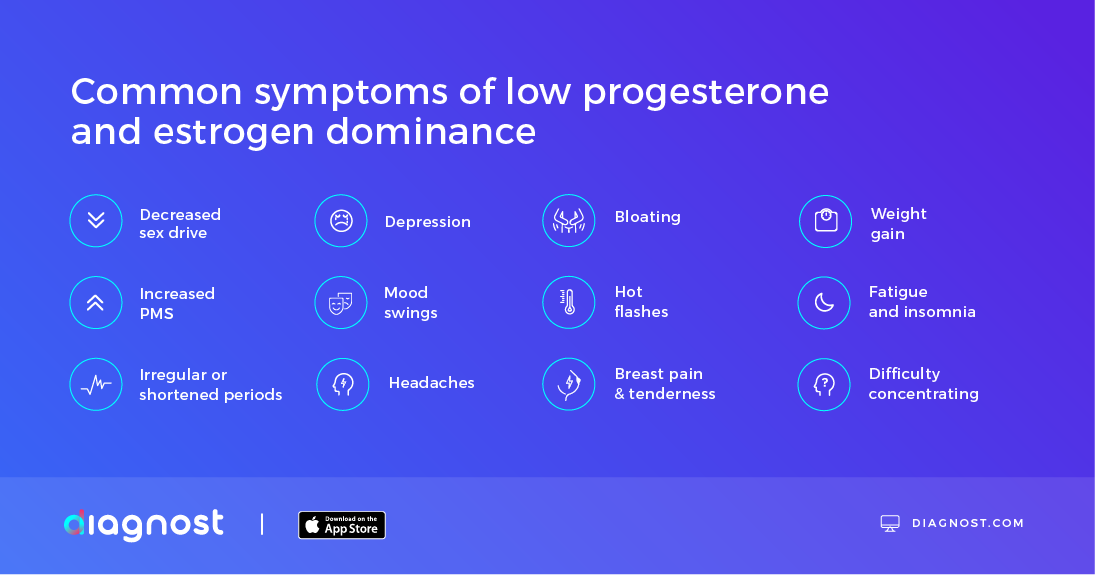Why Progesterone Is The Unsung Hero Of Women’s Health, And How To Boost It (+Video)
Tatiana Bakunina on May 30th, 2019Anyone who has a menstrual cycle, or knows anyone with one, knows that hormones are powerful things.
Those wanting to harness the full power of hormones to improve health and wellbeing have to ask two key questions: 1. How do I assess my current hormonal landscape and detect imbalances? 2. How do I rebalance the hormones in my system?
If you’ve wondered this (mystified, while in the throws of PMS) — fear no more! We’re bringing you this guide to boosting low progesterone levels for hormonal balance.
Hormones are invisible, but symptoms of imbalance are not
When a cold makes you weak, tired and hungry, you know it’s a cold. Why? The stream of gooey white stuff coming out your nose. You can see your illness and correctly identify its cause. When hormonal imbalances are throwing you off, it can be harder to work out what’s going on.
Well, that’s all about to change.
Diagnost’s home testing kits give you a full map of your internal hormonal and metabolic landscapes. We offer easy self-tests that you can administer yourself at home. Then, we send your tests to the lab and deliver your results to you via our app. Within a few days, you can access comprehensive information on your internal hormonal landscape.
When it comes to women’s health, we have noticed time and time again that low progesterone levels are one of the most under-acknowledged hormone imbalances that contribute to common health conditions. In this article, you’ll learn about what progesterone is, the benefits of boosting it, and how to do so – entirely naturally!
So what’s this progesterone thing anyway?
We’ve all heard about testosterone. It has long barged its way into hormonal discourse, leaving its over-qualified, under-paid female counterpart, progesterone, in the shadows. So what is progesterone?
Progesterone is the female sex hormone. It’s also a steroid, helping stimulate muscle growth in the lining of the uterus. Progesterone maintains this uterine lining for the 14 days post-ovulation, keeping your body ready for the possibility of conception and pregnancy. Once the egg isn’t fertilised, progesterone levels drop. This decrease in progesterone levels leads to all those unbearable symptoms of PMS.

In addition to playing a key role in regulating the monthly cycle, progesterone is also responsible for the best-feeling weeks of our cycle. It makes you feel more attractive and confident when you’re at your most fertile. In other words, progesterone is so powerful, it can make you feel friggin’ fantastic!
But that’s not all – progesterone balances out the negative effects of estrogen too. While estrogen plays an important part in our monthly cycles, the symptoms of estrogen dominance are less than desirable. So what does estrogen dominance look like?
Common symptoms of low progesterone and estrogen dominance include:

As the graphic above shows, the range of symptoms of progesterone deficiency and estrogen dominance is quite broad. Besides decreasing well-being by triggering headaches, bloating, hot flashes or breast pain and tenderness, it can also disrupt menstruation cycles, causing irregular or shortened periods and increased PMS. Weight gain and decreased sex drive are two additional symptoms that significantly influence the every-day life. Finally, this hormone imbalance can even have a major impact on our mental health, causing mood swings and depression, as well as affect our energy levels, leading to fatigue, difficulty to concentrate and even insomnia.
Luckily we can reduce these symptoms by boosting progesterone, to help your body get back to its natural, healthy balance. Let’s take a deep dive into the best practises for increasing your progesterone levels, naturally!
The dos and don’ts of boosting low progesterone naturally
You can boost your progesterone levels naturally by focusing on adding certain vitamins and minerals into your diet. These will create the optimal conditions for progesterone to flow forth, naturally.
Do:

Magnesium
This is a fun one to work on because magnesium is in some of the best foods: dark chocolate, nuts, avocados. Try this vegan avocado chocolate cake and sprinkle some nuts on top for extra crunch. Almonds, brazil nuts, and cashews are particularly good sources of magnesium at around 82mg per ounce – so focus on these as you make the progesterone cake of your dreams. It’s also found in beans and legumes so why not make a whole vegan dinner party out of your progesterone-boosting project? You’ll make your friends feel amazing too with some of these great recipes.
Happily, magnesium supplements are some of the best you can buy. Magnesium helps relax your muscles and alleviate anxiety. Studies have shown that magnesium helps improve sleep. And why not combine this with an evening bath in Epsom Salts and Magnesium Flakes for a relaxing wind-down into progesta-joy?
Zinc
Zinc is a mineral that makes you feel sparky and amazing. Research carried out by the World Health Organization has shown that nearly 75% of Americans suffer from a zinc deficiency. It’s time to fix that!
Zinc helps your pituitary gland regulate hormones. At the right time of the month, it helps the gland produce FSH hormones which tell your ovaries to produce progesterone. Aside from these hormonal benefits, Zinc also helps boost your immune system and promote overall wellbeing. Foods that are rich in Zinc include meat, shellfish, nuts, seeds, dark chocolate and whole grains.
Vitamin B6 and B12
Vitamins B6 and B12 also play key roles in keeping the hormones in your body at an optimal level. One research study showed that increasing B6 vitamin consumption to 200-800 mg each day can raise progesterone levels and reduce estrogen enough to improve symptoms of PMS. Other research shows the potential to increase fertility by up to 120% and reduce miscarriage rates by around 50%.
B6 has gained infamy as the essential vitamin that you can’t get on a vegan diet. For this reason, supplements abound. Whilst it’s easy to find plant-based B6 supplements, a serving of sweet potatoes or carrots can also provide up to 16% of the recommended daily intake. Alternatively, a serving of salmon or lean meat can provide almost 100% of all the B12 you need. That means whether you’re vegan, vegetarian or pescatarian, there are endless ways to get that all-important B6 in your system!
Don’t:

Stress
This won’t be the first time you’ve heard that when it comes to living healthily, stress won’t help. But it’s worth saying again. When things in your life trigger your adrenal glands to produce cortisol and adrenaline, just say no! Stress hormones actually use up progesterone that your body needs, so trying to keep calm in stressful situations will bring you positive returns – and your progesterone reserves will thank you.
Drink too much alcohol
Alcohol, in addition to everything else, changes the way your body produces estrogen and can raise your levels of estrogen and lower your progesterone levels. A study published in the 2000 edition of Alcohol and Alcoholism found that women who drank moderately had much lower levels of progesterone than non-drinkers. Too much alcohol can also keep you from absorbing that sparky Zinc we spoke about above. Instead of winding down with a glass of wine at the end of the day, why not try a Magnesium Bath with lavender essential oils or a Yin Yoga class.
Consume processed foods
Sadly, these days, processed foods are hard to avoid. Despite that, it’s important to know that many of them are packed with harmful byproducts such as xenoestrogens which contribute to estrogen dominance.
Most mass-farmed meat is pumped with synthetic hormones that are harmful to consume. Check that any meat you buy is labelled as “hormone-free.” Soy milk and tofu are other ones to avoid in excess. The ways in which soy has been genetically modified and processed on its way to becoming milk often lead to products becoming overloaded with estrogen. This means processed foods can disrupt your body’s natural hormonal balance and lower levels of progesterone in your body – so take care when the fast food cravings hit.
Conclusion
We should all be focusing more on fighting progesterone deficiency. Indeed, progesterone might be the missing link in your health questions. It’s hard to tell when hormones are behind our symptoms but, with Diagnost’s home testing kits, you can finally get to know your hormonal landscape and start to take steps to regulate it by encouraging the production of progesterone if your levels are too low.
Our old friend progesterone only wants the best for us, and many of the most impactful things we can do to encourage higher levels of this fabulous hormone simply involve good self-care: not stressing and making sure we’re getting key vitamins and minerals from healthy foods. Health radiates from the inside, out – so good luck!



